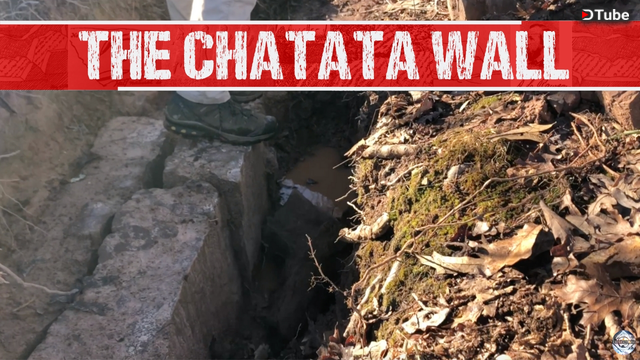
Hooper Farm was described as “being roughly 7 miles SW of Charleston and 13 miles from the railroad in Cleveland, TN.” The farm was said to have looked no different from the other neighboring tracts of land but had you gone to Bradley County, TN in the summer of 1891, anyone could have pointed in the direction of it. At this time this location was known around the World for its mysterious archeological find. Upon arriving there you would have seen evidence of a curved wall, stretching close to 1000 feet long, comprised of three courses of red sandstone blocks and said to have inscriptions on a small section of it.
The discovery was made by Isaac Hooper one day while looking for stones to add to his foundation to the Hooper Mill. A stone was found protruding about six inches above ground level. This stone turned out to be one of many markers showing the course of the wall. As Isaac picked up one being curious he decided to dig down where he found the wall itself. The wall was originally almost completely buried. It was said to run over 300 yards along the crest of a ridge and that above the wall at intervals,
The wall was described as being 2 1/2 feet thick, built of stones about 2 feet square and 10 inches thick, having three tiers of stone in which the strange characters appeared only on the west face of the middle tier. In the Herald Newspaper report, it states that stones found at the Mill were being exhibited and what was "thought to be hieroglyphics cut on them by some lost race who built the wall long before any white man lived."
Excavations, supported at first by the Smithsonian Institution, revealed a 3-ply sandstone wall-like structure 900 feet long, bearing hieroglyphic inscriptions on the west side of the middle tier.
In 1891 Dr. J. Hampden Porter of the Smithsonian Institute examined the markings on the wall, During his visit to Chatata that year. He made sketches of a section of the wall and impressions of the characters. He recognized animal forms and emblems, the old and the new moon, the destroying quoit, the thunderbird, the serpent and forms like many Old World alphabets. The Smithsonian Institute actually displayed a small segment 1ft x 1ft roughly of the wall from 1900-1902 when it was returned to the owner because there was “question” as to whether the markings constituted an inscription. Many still wonder if these inscriptions were judged wrongly or prematurely as the Smithsonian has been caught covering up, discrediting, or completely ignoring credible ancient history before such as the Kensington rune stone, bat creek stone, and many others. Any information that does not fit a certain vision of Columbus history.
The entire story would have remained unrecorded if it were not for noted New York professor A.L. Rawson visiting Cleveland one year later. He was staying overnight in a Cleveland hotel but on hearing mention of the find, extended his stay a few days to visit Hooper Farm. After viewing the wall he was keen to have the inscriptions deciphered. Employing a capable staff of cipher experts and expending $35,000, the hieroglyphics were declared to be old Hebrew and the inscription of religious and historical nature, written by scribes of a nation that was then at war and about to become extinct.
It was his opinion that the wall had been buried over 4,000 years, the protective covering of earth wearing away with the passage of time, bringing the formation nearer to the surface. He aimed to uncover the entire wall which was said to be located on what was described as a ridge.
Pottery and stone images were also found near the wall which Rawson also declared to be old Hebrew. Citing the story of the Two "Lost Tribes of Israel," he believed that the Israelite tribes entered America by way of the Bering Strait, allowing for the many geographic changes that have taken place during the past 4,000 years.
Who believed the writings to be ancient Hebrew Sanskrit and that it proved a connection from the Cherokee to the lost tribes of Israel. From the Batcreek High Priest Stone to the Newark “Holy Stones” this was believed to be even more evidence of this theory.
He declared that the tribes, after locating in the new country, inscribed the tablets with the Mosaic law in obedience to the injunction of Moses, and sealed them away for preservation, making reference to the 7th, 9th and 11th chapters of Deuteronomy, the 8th chapter of Joshua and the 3rd chapter of Judges.
Professor Rawson's translations created a worldwide interest within scientific and historical circles. Historians from as far as New Zealand, Japan, Italy, France, Spain, Cuba, and other countries came to visit Hooper Farm.
A 1970 newspaper report says just a huge hole on the Hooper farm remain as a mute reminder of the work done by Prof. Rawson half a century before…
Fact or fiction…
Excitement over the wall has dwindled and not many local folks agreed with the Hooper Farm story, however. Some say that although familiar with the story, there was no wall, just stones, and there was no ridge as described…
▶️ DTube
▶️ IPFS
Hi! I am a robot. I just upvoted you! I found similar content that readers might be interested in:
http://www.s8int.com/page27.html
Congratulations @adventuresunited! You received a personal award!
You can view your badges on your Steem Board and compare to others on the Steem Ranking
Vote for @Steemitboard as a witness to get one more award and increased upvotes!